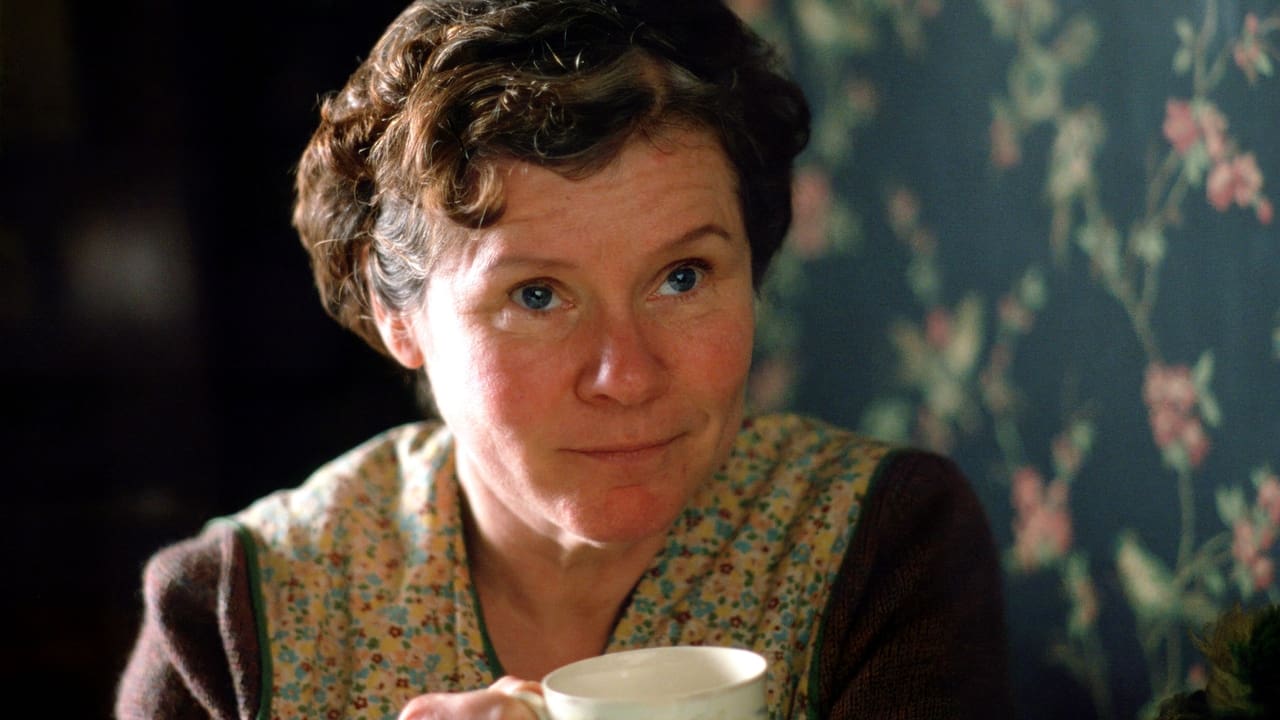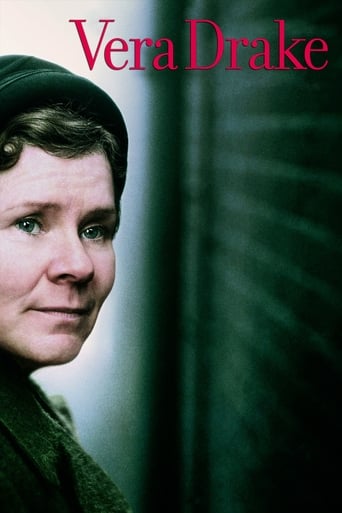

Best movie of this year hands down!
... View MoreTruly Dreadful Film
... View MoreAbsolutely amazing
... View MoreThe movie really just wants to entertain people.
... View MoreAbortions have never been done the way they are presented in this movie with any lasting regularity, and certainly not by the same person, over and over. Doing an abortion using the method portrayed in this movie causes internal bleeding and death, almost 95% of the time-watch Revolutionary Road. Vera Drake would have killed hundreds of women. Surgical abortions have been taking place since the 1800s. Traveling abortionists were almost always male. No one in the world does abortions for free. It's a money game-always has been. Period. This movie is false from top to bottom. Perhaps it makes people "feel good" because of the pro-choice message, but it's false and totally inaccurate. I only gave it more than one star because the acting was good.
... View MoreOn the surface it looks simple: a "realistic" movie depicting 1950 London and portraying a kind character fighting unfair anti-abortion laws. But is it just that?REALISM TRANSCENDED BY IMAGE Granted, the historical reconstitution is convincing. Exteriors and interiors are life-like. Social types are well outlined. However Mike Leigh sublimes this realism, providing an archetypal rendering.Colours and lighting have a purpose: showing the opposition of living standards. On the one hand, cold colours and dim lighting for middle and lower classes: dwellings, workplaces, etc. On the other, warm colours and bright lighting for upper classes and institutions: homes (including Frank's), doctor, psychiatrist, clinic, courtroom, jail, etc. This contrast is by no means "natural": notably, the brightness in jail is surprising.The camera emphasises this opposition: we seem to bump into walls and persons at Vera's home; shots are close, camera movements are rare as if we could barely move. In contrast, in the bourgeois' home, shots are more distant and the camera moves as if to benefit from available space.This sublimed vision has an objective: going beyond the description of a period to deal with universal themes, i.e. social classes, money, abortion, justice, values. AND BY ACTINGMain actors rehearsed extensively before shooting started: lengthy discussions about script and characters, thorough documentation about the period and personalities, improvisation of scenes that were afterwards used in the movie or not. This largely explains the "real life" feeling of the movie.However, just as noted above for image, this acting method transcends roles: actors do not just portray historical persons, they enrich characters with their own personalities and emotions. Immersion is a two-way street: actors grow into roles and inversely characters are modelled on actual individuals. This provides extra depth to characters and makes us feel closer to them: they are just not bygone persons, it seems we could meet them nowadays.It has been said many times, nonetheless let's repeat: Imelda Staunton's performance is absolutely outstanding and explains to a large extent the quality of the movie. Other actors are also excellent, even in minor roles.CHARACTERS WE CAN CONNECT TOAll characters are sympathetic with only two exceptions: Lily who immorally profits from abortions and black market; Joyce who is rigid and greedy. This approach is intentional: we understand how everyone thinks. A doctor informs the police, but has no choice. The police arrest Vera, but are decent. A mother gives Vera away, but only after undergoing pressure from the police. A doctor and the psychiatrist benefit from the abortion "business", but are confined by the system. The magistrate is ruthless, but complies with the law.Conversely, if Vera is kind, she is not a saint, which prevents the movie from being one- sided. She means well, however her methods are dangerous: because of her a young woman almost dies. Technically she "helps young girls out", yet fails to deliver an essential psychological support: once finished she goes rapidly, leaving the despaired women alone. She is so naive she does not understand her "friend" Lily is exploiting her. She does not evaluate the consequences of her action, notably for her family who at the end is left morose.ABORTION: IS THE MOVIE PRO-CHOICE?The movie is not a straightforward pro-choice manifesto. We hear arguments from both sides. On the one hand, the friendly Sid cannot understand nor forgive what Vera has done. Even the fair Stan and Frank do not take sides. There is a general condemnation of abortion.On the other, wealthy families can bypass the law, while poor or even middle-class families cannot. Because abortions have to be illegal, a woman almost dies. Reg delivers a powerful quote: "It don't seem fair. Look at my mom: six of us in two rooms. It's all right if you're rich, but if you can't feed them, you can't love them, can you?" Hence the message is pro-choice in the context of social inequalities. Is this message universal? Each spectator will decide for oneself.We witness seven abortions (of which six performed by Vera) in different contexts, which illustrates the complexity of the topic: rape, inability to raise another child, infidelity (probably), prostitution (probably).COMPELLING SCENESI believe every major movie has at least a prominent scene, condensing its main qualities. "Vera Drake" has two. The first one is when the police arrive at Vera's home. We go through a roller-coaster of emotions: surprise, incredulity, fear, despair, resignation. The dialogue between the inspector and Vera is exceptionally intense, highlighted by sharp reversed shots.The other scene is at the police station, when Vera reveals to her husband Stan what she has done. At first, two officers are in the background. Slowly, the camera zooms in Vera and Stan: one officer moves off-screen. Then Vera bends over to Stan, hiding the other officer: Vera's action has turned from unlawful to personal. There is an incredibly tense moment when she cannot voice what she did while he eagerly waits for the revelation. Finally she whispers to his ear something we cannot hear: her action is beyond audible words.DRAMATIC BUILD-UPThe movie progressively moves from a light to a dark mood. It first depicts the modest but happy life of a woman and her family. There are a few humorous moments: Sid tailors a suit for a half-wit, the family gathers, they go to the movies. Increasingly, sad events disrupt this ambiance: Vera takes care of a poor family and her ill mother, she performs illegal abortions, a woman is raped, Vera is arrested. It then goes completely downhill until the final twist: in jail, Vera realises that illegal abortions are commonplace and that the horror of being imprisoned seems trivial to many women.In summary, "Vera Drake" manages to reconcile opposites: simple yet powerful, realistic yet artistic, meaningful without propaganda, intense without exaggeration.
... View MoreI am a big fan of Mike Leigh's work, he has directed some very good movies covering a wide range of subjects. Whilst the concept of this movie is very good, I have a few problems with the central character. The portrayal of Vera Drake doesn't come across as believable to me. I'm well aware that there were back-street abortionists during these times, but this woman's character as a very meek and mild home-maker who is known in her community for helping out elderly and infirm family members, doesn't come across as someone who would know how to perform this act, and also do it in a way that was as normal as preparing a meal for her family. Despite that, the film does have a lot of merit. There is the distinction of how somebody who comes from a good social background can get the abortion performed in a proper clinical way - so long as you can afford the money. Vera performs hers on people who have next to no money and during a time when there wasn't much in the way of Social Security. It portrays an era very well. She keeps her 'work' hidden from her family and when it is discovered it has a devastating effect on all of them. Despite my misgivings, this movie is definitely worth a watch. A gritty drama set in the 50's/60's.
... View MoreOstensibly, a simple picture about the unmasking of a back-street abortionist in post-war London. This part of the project is accomplished straightforwardly enough. What distinguishes this film of Mike Leigh's though is threefold.Firstly it's a fascinating concoction of high, sustained emotion and moral neutrality. Throughout there is a great sense of warmth and sympathy - and characters have varying degrees of appeal - but at the film's close it is impossible to judge on which side of the 'pro-life' argument Leigh has settled.Secondly, and closely allied to the first, is the meticulously observed sense of period. Vera Drake is at the centre of a loving working-class family, weaned on the pragmatism and austerity of wartime; adept at capitalising on meagre joys and dealing with a disproportionately distressing recent past. Through the character of Vera Drake, this juxtaposition shadows the bittersweet gift of pregnancy with its life - joy and bleached by impossibility. It's in the bizarre, lowly domesticity that characters share great moments of love and loss that the film has traction - Vera rushes around, 'as good as gold', breaking the law and administering foeticide. Now, neither of these two characteristics of the film would have any interest without the high quality of the acting, given that they are so opposite. The entire cast are quite brilliant and crowned with a (surely once-in-a-lifetime) titular characterisation by Imelda Staunton. I have seen Million Dollar Baby, for which Hilary Swank snapped up a second Oscar: a deserving candidate for a serious award but not on the same planet as this extraordinary, personally transubstantive rendition of opaque, postwar feminine complexity. The close, single-take shot of Vera being confronted by the police is its central miracle: watch the light literally dying in Staunton's eyes. 8/10
... View More